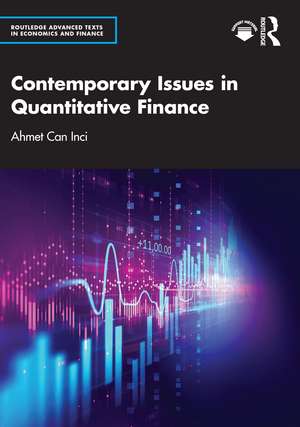Contemporary Issues in Quantitative Finance: Routledge Advanced Texts in Economics and Finance
Autor Ahmet Can Incien Limba Engleză Paperback – 10 apr 2023
| Toate formatele și edițiile | Preț | Express |
|---|---|---|
| Paperback (1) | 495.65 lei 6-8 săpt. | |
| Taylor & Francis – 10 apr 2023 | 495.65 lei 6-8 săpt. | |
| Hardback (1) | 900.51 lei 6-8 săpt. | |
| Taylor & Francis – 10 apr 2023 | 900.51 lei 6-8 săpt. |
Din seria Routledge Advanced Texts in Economics and Finance
- 8%
 Preț: 401.73 lei
Preț: 401.73 lei -
 Preț: 433.90 lei
Preț: 433.90 lei - 8%
 Preț: 515.63 lei
Preț: 515.63 lei - 8%
 Preț: 390.06 lei
Preț: 390.06 lei - 21%
 Preț: 412.42 lei
Preț: 412.42 lei - 15%
 Preț: 685.52 lei
Preț: 685.52 lei - 15%
 Preț: 449.19 lei
Preț: 449.19 lei - 15%
 Preț: 595.23 lei
Preț: 595.23 lei - 25%
 Preț: 490.28 lei
Preț: 490.28 lei -
 Preț: 288.77 lei
Preț: 288.77 lei - 15%
 Preț: 692.65 lei
Preț: 692.65 lei - 20%
 Preț: 307.06 lei
Preț: 307.06 lei - 25%
 Preț: 1030.51 lei
Preț: 1030.51 lei - 15%
 Preț: 579.25 lei
Preț: 579.25 lei - 15%
 Preț: 460.56 lei
Preț: 460.56 lei - 15%
 Preț: 531.04 lei
Preț: 531.04 lei - 31%
 Preț: 369.87 lei
Preț: 369.87 lei - 15%
 Preț: 564.00 lei
Preț: 564.00 lei - 15%
 Preț: 550.77 lei
Preț: 550.77 lei - 15%
 Preț: 665.87 lei
Preț: 665.87 lei - 26%
 Preț: 934.46 lei
Preț: 934.46 lei -
 Preț: 364.94 lei
Preț: 364.94 lei - 31%
 Preț: 322.47 lei
Preț: 322.47 lei - 25%
 Preț: 993.02 lei
Preț: 993.02 lei - 15%
 Preț: 456.13 lei
Preț: 456.13 lei - 15%
 Preț: 580.07 lei
Preț: 580.07 lei -
 Preț: 433.30 lei
Preț: 433.30 lei - 15%
 Preț: 438.14 lei
Preț: 438.14 lei - 18%
 Preț: 1330.65 lei
Preț: 1330.65 lei - 5%
 Preț: 639.70 lei
Preț: 639.70 lei
Preț: 495.65 lei
Nou
94.84€ • 98.83$ • 78.53£
Carte tipărită la comandă
Livrare economică 03-17 aprilie
Specificații
ISBN-10: 1032101121
Pagini: 302
Ilustrații: 2 Tables, black and white; 88 Line drawings, black and white; 1 Halftones, black and white; 89 Illustrations, black and white
Dimensiuni: 174 x 246 x 16 mm
Greutate: 0.49 kg
Ediția:1
Editura: Taylor & Francis
Colecția Routledge
Seria Routledge Advanced Texts in Economics and Finance
Locul publicării:Oxford, United Kingdom
Public țintă
Postgraduate and Undergraduate AdvancedCuprins
1. Introduction: History, Present, Future of Financial Markets and Securities, 2. Global Finance, 3. Financial Crises: Reasons, Consequences, Lessons, 4. Trading Ecosystem: History, Speed, Orders, Intraday, E.S.G., 5. Asset Pricing Models, 6. Modern Portfolio Theory and Optimization, 7. Hedge Funds, Mutual Funds, E.T.F.s, 8. Stochastic Calculus, 9. Monte Carlo Simulations, 10. Value-at-Risk [VaR], 11. Fixed-Income Securities, Term Structure of Interest Rates, 12. Options: Introduction, 13. Options: Binomial Tree Model, 14. Options: Black-Scholes-Merton Model, 15. Options: Greeks and Risk Management, 16. Forwards and Futures, 17. Alternative Investments, 18. Currency, Cryptocurrency, Blockchain, Fintech, 19. Artificial Intelligence in Finance, 20. Big Data Analytics
Notă biografică
Ahmet Can Inci is Professor of Finance at Bryant University in Rhode Island, U.S.A. He received his Ph.D. from the University of Michigan, Ann Arbor, in 2001. He holds an M.B.A. from Ohio State University, an M.Sc. in control systems from Imperial College ¿ University of London, and a B.Sc. in electrical and electronics engineering from Bogazici University in Istanbul. Professor Inci¿s research interests include exchange rate dynamics, corporate governance, emerging markets, oil and energy, futures, contagion and flight to quality, the gender gap at the workplace, insider trading, intraday volatility, and market efficiency. He teaches innovations in finance, international finance and business, investments, corporate finance, foundations of financial theory, financial analytics, and financial engineering. He is a C.A.I.A. member, A.A.S.C.B. program consultant/reviewer, and editorial board member of numerous academic journals.
Descriere
Contemporary quantitative finance connects the abstract theory and the practical use of financial innovations, such as ultra-high-frequency trading and cryptocurrencies. It teaches students how to use cutting-edge computational techniques, mathematical tools, and statistical methodologies, with a focus on real-life applications.
The textbook opens with chapters on financial markets, global finance, and financial crises, setting the subject in its historical and international context. It then examines key topics in modern quantitative finance, including asset pricing, exchange-traded funds, Monte Carlo simulations, options, alternative investments, artificial intelligence, and big data analytics in finance. Complex theory is condensed to intuition, with appendices presenting advanced mathematical or statistical techniques. Each chapter offers Excel-based implementations, conceptual questions, quantitative problems, and a research project, giving students ample opportunity to develop their skills. Clear chapter objectives, summaries, and key terms also support student learning.
Digital supplements, including code and PowerPoint slides, are available for instructors. Assuming some prior financial education, this textbook is suited to upper-level undergraduate and postgraduate courses in quantitative finance, financial engineering, and derivatives.
